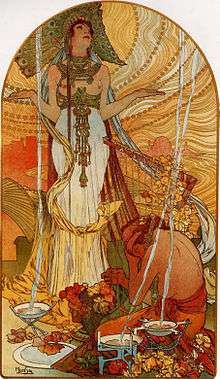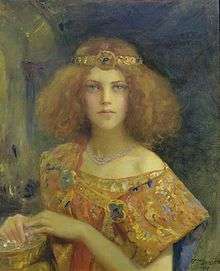Salammbô

Salammbô (1862) is a historical novel by Gustave Flaubert.[1] It is set in Carthage during the 3rd century BC,[1] immediately before and during the Mercenary Revolt which took place shortly after the First Punic War. Flaubert's main source was Book I of Polybius's Histories. The novel kickstarted a renewed interest in the history of the pre-Imperial Rome's conflict with the North African Phoenician colony of Carthage.
Flaubert's contemporary readers, familiar with his previous realistic work Madame Bovary, were shocked and, in some instances, even appalled by the indiscriminate violence and sensuality prevalent all throughout the novel which is why, notwithstanding the praise it received for the style it was written in as well as the story it tells, Salammbô remains controversial among the literary circles even to this day. Regardless, it was a massive best-seller which sealed the author's reputation as one of the most prominent French writers of the 19th century, with even some of the Carthaginian costumes described in it making an impact on the contemporary fashion in France. Since then, however, it has fallen into obscurity in much of the Anglophone world.
Plot

After the First Punic War, Carthage is unable to fulfill promises made to its army of mercenaries, and finds itself under attack. The fictional title character, a priestess and the daughter of Hamilcar Barca, the foremost Carthaginian general, is the object of the obsessive lust of Matho, a leader of the mercenaries. With the help of the scheming freed slave, Spendius, Matho steals the sacred veil of Carthage, the Zaïmph, prompting Salammbô to enter the mercenaries' camp in an attempt to steal it back. The Zaïmph is an ornate bejewelled veil draped about the statue of the goddess Tanit in the sanctum sanctorum of her temple: the veil is the city's guardian and touching it will bring death to the perpetrator.
- Chapter 1. "The Feast". During a victory banquet, the mercenaries destroy Hamilcar's garden for sport in his absence. Hamilcar's daughter Salammbô tries to quell the riot. Matho falls in love with her. The slave Spendius is released, and he tries to persuade Matho to take Carthage for the mercenaries.
- Chapter 2. "At Sicca". The mercenaries leave the city unpaid and travel to Sicca. Later, Hanno comes and speaks to the mercenaries about delays in recompensing them, but he is driven off when Zarxas arrives and tells them of a treacherous massacre of 300 slingers who had stayed behind.
- Chapter 3. "Salammbô". Hamilcar's daughter prays and is instructed by Schahabarim.
- Chapter 4. "Beneath the Walls of Carthage". The mercenaries besiege Carthage; Matho and Spendius penetrate via the aqueduct.
- Chapter 5. "Tanit". Matho and Spendius steal the Zaïmph. Because Matho is caught while breaking into Salammbô's bedroom to see her again, she falls under suspicion of complicity.
- Chapter 6. "Hanno". The mercenaries leave Carthage and split into two groups, attacking Utica and Hippo-Zarytus. Hanno surprises Spendius at Utica, and occupies the city, but flees when Matho arrives and routs his troops.
- Chapter 7. "Hamilcar Barca". The hero returns and an attempt is made to blame him for Hanno's losses. He defends himself before the Council and defends the mercenaries, but turns against the barbarians when he sees the damage they have done to his property.
- Chapter 8. "The Battle of the Macar". Hamilcar defeats Spendius at the bridge of the Macar, three miles from Utica.
- Chapter 9. "In the Field". Hamilcar's troops are trapped by the mercenaries.
- Chapter 10. "The Serpent". Schahabarim sends Salammbô in disguise to retrieve the Zaïmph.
- Chapter 11. "In the Tent". Salammbô reaches Matho in his tent at the encampment. Believing each other to be divine apparitions, they make love. The mercenaries are attacked and dispersed by Hamilcar's troops. She takes away the Zaïmph, and on meeting her father, Hamilcar has her betrothed to Narr' Havas, a mercenary who has changed sides.
- Chapter 12. "The Aqueduct". The Carthaginians return to their city with the mercenaries in pursuit. Spendius cuts off the water supply to Carthage.
- Chapter 13. "Moloch". Carthaginian children are sacrificed to Moloch. Hamilcar disguises a slave-child as his son Hannibal and sends him to die in his son's place.
- Chapter 14. "The Defile of the Axe". The drought is broken and aid comes. Hamilcar drives the mercenaries away from their encampments. Later, thousands of mercenaries are trapped in a defile and slowly starve (the Battle of "The Saw"). Deaths of Hanno and Spendius, both by crucifixion.
- Chapter 15. "Matho". Victory celebrations at Carthage. Matho is tortured before his execution; Salammbô, witnessing this, dies of shock. The Zaïmph has brought death upon those who touched it.
Characters
The transliterations follow J. W. Matthews's English version.
- Abdalonim, the overseer of Hamilcar's stewards
- Autharitus (Autharite), a Gallic leader of the Mercenaries
- Demonades, a servant of Hanno
- Giddenem, the governor of Hamilcar's slaves
- Gisco (Gesco), a Carthaginian general
- Hamilcar Barca (Amilcar), Carthaginian general who led the mercenaries before the events of the book
- Hannibal, Hamilcar's young son
- Hanno (Hannon), a Carthaginian general (based on Hanno the Great and the Hannibal of the Mercenary War)
- Iddibal, a servant of Hamilcar
- Matho (or Mâthos), a Libyan leader of the Mercenaries
- Narr' Havas (Flaubert's spelling of Naravas), prince of the Numidians, and a leader of the Mercenaries
- Salammbô, daughter of Hamilcar
- Schahabarim, high priest of Tanith, and teacher of Salammbô
- Spendius, a slave of Hamilcar, captured at the battle of Argunisae, who becomes a leader of the Mercenaries during the Revolt
- Taanach, a slave attending Salammbô
- Zarxas (Zarzas), a leader of the Mercenaries from the Balearic Isles
Notable quotations
It was at Megara, a suburb of Carthage, in the gardens of Hamilcar, that the soldiers whom he had commanded in Sicily were holding a great feast to celebrate the anniversary of the Battle of Eryx. The master was absent, their numbers were large, and accordingly they ate and drank in perfect freedom.
—The opening words.
The brazen arms were working more quickly. They paused no longer. Every time that a child was placed in them the priests of Moloch spread out their hands upon him to burden him with the crimes of the people, vociferating: "They are not men but oxen!" and the multitude round about repeated: "Oxen! oxen!" The devout exclaimed: "Lord! Eat!".
—Chapter 13 ("Moloch"), the passage describing the burning of the children inside the huge, hollow brass statue of the Baal Moloch.
Historical inaccuracies
Every once in a while there are departures from Polybius's historical account, albeit some of them were made intentionally by Flaubert. For example, in reality it was not Hanno who was crucified by the mercenaries but a Carthaginian general known as Hannibal. Fearing that the readers would mistakenly assume this figure to be the famed military commander of the Second Punic War, the author changed the name of his novel counterpart.
Adaptations
Salammbô inspired Jacques Martin to create his historical comics series Alix. [2]
Musical
- Salammbô, an unfinished opera by Modest Mussorgsky (1863–66)
- Salammbô, another unfinished opera by Sergei Rachmaninoff
- Salammbô, an opera composed by Ernest Reyer based on Flaubert's novel (1890).
- Salammbo (Florent Schmitt): Three orchestral suites op. 76, from the music for the 1925 film by Pierre Maradon
- Salammbo, an opera composed by Josef Matthias Hauer based on Flaubert's novel (1929).
- Salammbo, the fictional opera from Orson Welles' film Citizen Kane: see below under "Film".
- Salammbô, an opera by the French composer Philippe Fénelon, on a libretto by Jean-Yves Masson after Flaubert (1998)
Film
- Salambò, a 1915 Italian silent film by Domenico Gaido, released in Italy in October 1914. First U.S. release on 3 March 1915
- Salammbô, a 1925 silent film by Pierre Marodon, with music by Florent Schmitt
- The Loves of Salammbo, a sword and sandal film by Sergio Grieco (1962)
- Salammbo is the title of a fictional opera used in Orson Welles' film Citizen Kane. Charles Foster Kane's ill-fated second wife, Susan Kane, premiers in the opera and her performance is panned by the critics. The segment featured in the film, Salammbo's Aria, was composed by Bernard Herrmann.
Other
- Salammbo, a play by Charles Ludlam (1988)
- Salammbô, a series of science fiction graphic novels by Phillippe Druillet (1980, 1982, 1986)
- Salammbo: Battle for Carthage is the title of a Windows game by Dreamcatcher Interactive with artwork by Druillet. Its story is based on both Gustave Flaubert's and Phillipe Druillet's works (2003)
- "Salammbô", a short story by Caitlín R. Kiernan (1999)
- "Salammbô Redux", a short story by Caitlín R. Kiernan (2007)
Salammbô in art
 Salammbô, Gaston Bussière (1907)
Salammbô, Gaston Bussière (1907) Salammbô by Auguste Rodin
Salammbô by Auguste Rodin Salammbô by Henri Adrien Tanoux (1921)
Salammbô by Henri Adrien Tanoux (1921)- Salammbô, sculpture by Antonin Idrac (1903)
References
- 1 2 Miles, Richard (2010). Carthage Must Be Destroyed: The Rise and Fall of an Ancient Civilization. New York: Penguin Books. p. 10–11. ISBN 978-0-14-312129-9. OCLC 782056349.
- ↑ https://www.lambiek.net/artists/m/martin_jacq.htm
External links
| Wikimedia Commons has media related to Salammbô. |
| French Wikisource has original text related to this article: |
Texts
- Salammbô at Project Gutenberg (French)
- Salammbô at Project Gutenberg (English)
Audio
Other
- The famous sculpture Salammbô at the Lady Lever Art Gallery